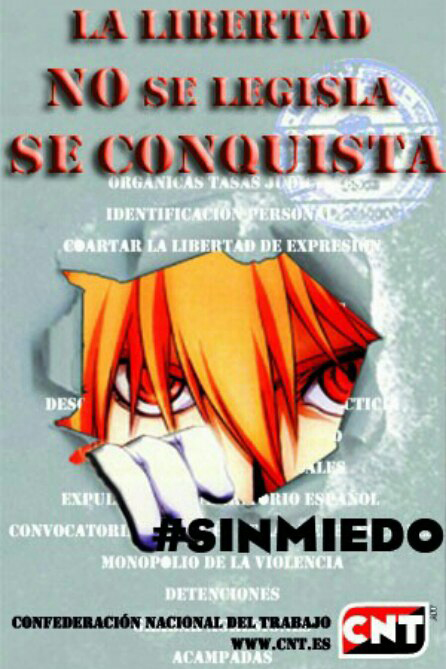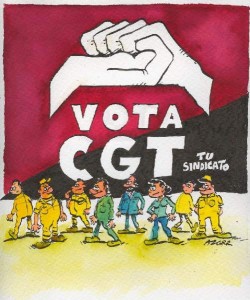My previous posts on the splits within the Spanish CNT and the split between the CNT and the IWA-AIT (International Workers’ Association) have been generating a lot of traffic in the wake of the CNT organized “Bilbao” conference (November 26 – 27, 2016, which ended up being held in Barakaldo), and the recent IWA-AIT congress in Poland (December 2 – 4, 2016). Reports regarding the Barakaldo conference have so far been very sketchy. Delegates from the CNT National federation and its current affiliates met with delegates from the German FAU, the Italian USI and other syndicalist organizations, with observers from groups like the IWW (Industrial Workers of the World). While it does not appear that they have yet created their own version of the IWA-AIT, as was their stated intention, at the IWA-AIT Congress it was decided to expel the CNT national organization and affiliates, while allowing CNT groups that have split with the CNT National organization, or which themselves have been “disaffiliated” by the CNT, to remain part of the IWA-AIT. The FAU and USI were also expelled.
One of the most difficult things to decipher in this debacle is what is actually generating this split in what remains of the international anarcho-syndicalist movement. The CNT complains that the IWA-AIT’s current structure gives tiny affiliates that are not even functioning trade unions equal votes with much larger groups that continue to act as revolutionary trade unions. The IWA-AIT suggests that the CNT and the other groups are moving away from an anarcho-syndicalist approach towards a more reformist form of revolutionary syndicalism, which is not even necessarily committed to the abolition of the state. Given these competing claims, it is unclear regarding what distinguishes the CNT from the Spanish CGT, which split (or was expelled from) the CNT in the early 1980s because of its willingness to adapt to current labour relations regimes, including participation in the state-regulated “works councils” in Spain, which results in the receipt of some state funding. The following is a statement from the CNT regarding the differences between the CNT and the CGT, which predates the split between the CNT and the IWA-AIT. This article was originally published on the website of the Valencia federation of the CNT: http://valencia.cnt.es/que-es-la-cnt/diferencias-entre-cnt-y-cgt/. It has been translated into English by Jeffrey Swartz, whom I thank for making this available.
Differences between the CNT and the CGT
With the goal of addressing a series of doubts frequently raised by sympathizers and others interested in our principles, tactics and goals, we believe it would be helpful to briefly lay out some of the differences in working methods and union strategy between the Confederación Nacional del Trabajo (CNT) and the Confederación General del Trabajo (CGT). Quite often workers come to join our union with the mistaken idea that the CNT had disappeared and had been transformed into the CGT. We have also met members of the CGT who are convinced that the CNT no longer exists. Then there are other workers who believe that the two union organizations share the same anarcho-syndicalist strategy.
The first thing we should do before analyzing the basic differences between the two organizations is study their history and how they were founded. In this regard we offer this link to our Web – a key reading source – where the period when the schism that emerged in the CNT is described in detail: 1979-1989: the process of the schism; Funded unionism and the crisis of the worker’s movement
UNION ELECTIONS AND WORKS COUNCILS
The union branches constituted by the affiliated workers of the CGT run for union elections and elected delegates can become members of the works council corresponding to the company in question. The union delegate enjoys the advantage of immunity from being fired, as granted by Spain’s Organic Law of Union Freedom (the Ley Orgánica de Libertad Sindical, or LOLS), framed within the model of unitary representation. These privileges are not enjoyed by their fellow workers. They also include maintaining workers who have been “freed up”, that is, workers who are not required to work when the majority of votes and the accumulation of union hours make such a circumstance possible. This means that they are no longer found at their full-time job posts, as they dedicate their time to “strictly union” tasks.
In contrast, the union branch (or section) comprised of workers of the CNT, establishes its own representation in the relevant enterprise and does not run for union elections or take part in works councils. The delegates in the section are elected in the Assembly and their responsibilities can be revoked at any time. Furthermore, they do not have privileges in relation to their fellow workers and do not live from their union activity. The entire body of workers affiliated to the CNT protect themselves mutually and together with the rest of the workers they defend pertinent workplace improvements and the strategy to be followed for each situation. In this way workers feel part and parcel of their own demands and participate actively in advancing them, avoiding delegation and acting directly against the company bosses. Direct action without intermediaries is the premise to be followed, given that an attempt is always made to prioritize union action over any sort of legal option, which is resorted to only for those cases where it is strictly necessary. The respective CNT union committee has a direct connection with the broader activity of the union, with its agreements and union strategy.
STATE GRANTS
Each year the CGT receives an important sum of money from the State. These funds come from grants given in proportion to union representation in those companies where it is active. This quantity is determined by the number of delegates obtained in union elections, that is, of the percentage of “representation” achieved. To give an example, in 2011 the Confederación General del Trabajo (CGT) received a sum of €218,684.29 (see the Official State Bulletin, BOE-A-2011-3079), while in 2012 it received €223,490.65 (see BOE-A-2012-10936).
The CNT, because it does not participate in union elections, totally rejects these grants, wherever they may come from, as is clearly expressed in its Statutes. Financing of the union branches of the CNT is based on self-management and is drawn from membership fees and other sources, as agreed upon by the union Assembly (voluntary and disinterested contributions from members and sympathizers, as well as from dinners, other events and various sources). It does not receive any sum at all from training courses, while all employment training is the responsibility of the CNT Union branch in question. In this way the union is fully autonomous in its decision-making and in the development of its syndicalist activity within any given company.
HIRED SALARIED WORKERS
The CGT has the possibility of hiring salaried workers in its Unions. The federated unions of the CGT have full autonomy for hiring salaried workers in order to fulfill union tasks. The unions of the CGT have on staff various Secretaries hired with contracts that could resemble that of any company. A recent example is that of the Secretary for Social Action serving the Territorial Confederation of the CGT in Madrid, Castile-La Mancha and Estremadura, who was fired by the CGT because his work interfered with his responsibilities as a clerk in the Sanitation Union, which also pertained to the CGT.
The CNT does not have paid posts in its organization. None of the Secretaries of the various Councils has a paid position. The Councils of the CNT are only coordinating organisms, offering external representation and implementing accords agreed upon in the Assemblies of the various branches of the confederation. They do not have decision-making power, but are elected by the members; their posts can be revoked at any time. Members of religious sects and those who have run for positions in any political organization cannot occupy posts in the CNT. This is a way of keeping decision-making capacity inside the Assemblies of the federated unions and ensuring syndicalism is not politicized. The fact of not having salaried workers eliminates internal “power” struggles, as seen in other organizations, so that militant labour as determined by membership manages and develops the union’s own activity.
OTHER CONSIDERATIONS
Apart from the most important differences described above, there are other considerations that make the CNT and the CGT quite different organizations. The CGT, in its Statutes, continues to make a claim for the economic patrimony of the CNT that might correspond to it (Section XI, Art.74), as if that organization could proclaim itself the rightful heir of the Confederación Nacional del Trabajo (CNT). In contrast, the CNT has spent many years making claims to the economic patrimony that had benefited its affiliated workers before it was plundered by the Franco dictatorship. In economic terms the CNT has recovered less than a third of the sum of the confederation’s rightful patrimony.
The CNT is affiliated with the Asociación Internacional de Trabajadores (AIT), which is made up of different organizations active in revolutionary syndicalism throughout the world. There can only be a single affiliate per country, and thus the CGT is not a part of the AIT. This is one of the reasons, as well as the fact that it is not considered a revolutionary organization, given that it receives state funding and participates in the model of corporative delegation made evident by the works councils. The CGT is part of a kind of parallel “International” called the “Red-Black Coordination”, made up of a few reformist unions in Europe whose functionality and union practice is very similar to the CGT.
NOTE:
In this article we have cited a few of the most significant differences found between the two union organizations. We wish to comment that with these clarifications we simply seek to respond to many of the doubts and questions frequently arising amongst sympathizers and others interested in these questions. For this reason we wish to insist that it is not the intention of the CNT to attack or discredit the CGT, and even less so its affiliated members. This information should be read as an analysis, a reminder that our union model fully rejects participation in union elections, works councils and state funding.
A demonstration of what we are insisting upon here can be seen on the overall level of the confederation (throughout the territory of the Spanish State). We collaborate closely with the CGT in various mass campaigns fighting against cutbacks and in favour of social solidarity, understanding that this is the only way to put a halt to attacks against the working class. Even so, each union federation of the CNT, within its respective autonomy, decides in Assembly what organizations and collectives it will work with, and to what degree.






“The CNT complains that the IWA-AIT’s current structure gives tiny affiliates that are not even functioning trade unions equal votes with much larger groups that continue to act as revolutionary trade unions”
Two comments I’d like to make; the current structure of the IWA has been in place for over thirty years. One wonders why it is an issue now. The workplace organising of some of the smaller affiliates are simply ignored for the purpose of maintaining the narrative.
The question of what is really generating the split in the CNT is a good one but remains unanswered. Answers may not be forthcoming anytime soon as the CNT confedral committee has complained of being ‘monitored’ by the IWA Secretariat and suggested they are the victim of an ‘inquisition’.